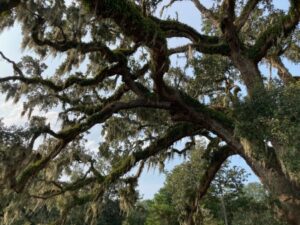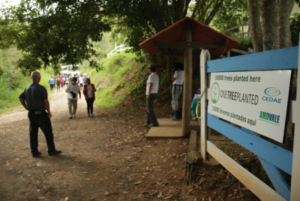For more than a decade, I had admired the massive ancient oak trees in my neighbor’s yard. When one of them came down in a storm a few years ago, I was awed by what I saw. When the tree stood upright, I saw strength and majesty. As the tree lay on the ground before me, I saw an intricate complexity to life that I had never before fully comprehended. It was a sacred experience.
 I saw complex crevices and cavities in the trunk and canopy. Moss and lichens grew intertwined with the bark of the trunk and tremendous branches. Cavities of decaying wood offered homes to a diversity of birds, arthropods and fungal inhabitants. The leaves supported evidence of diverse insect feeders. I realized this single ancient tree was an ecosystem in itself for an unimaginable diversity of interdependent species. How many birds and insects had nested in and fed on this tree? How many deer, rodents and insects relied on its acorns? How much CO2 had that tree removed from the atmosphere in its lifetime? I realized that so much more had been lost than a tree.
I saw complex crevices and cavities in the trunk and canopy. Moss and lichens grew intertwined with the bark of the trunk and tremendous branches. Cavities of decaying wood offered homes to a diversity of birds, arthropods and fungal inhabitants. The leaves supported evidence of diverse insect feeders. I realized this single ancient tree was an ecosystem in itself for an unimaginable diversity of interdependent species. How many birds and insects had nested in and fed on this tree? How many deer, rodents and insects relied on its acorns? How much CO2 had that tree removed from the atmosphere in its lifetime? I realized that so much more had been lost than a tree.
 In a sense, losing a tree like this is analogous to losing our tropical rainforests where species diversity is greater than in any other land ecosystem on Earth. They are the lungs of our planet. They are the sacred home to indigenous tribes who rely on the forests to continue their cultures. Tropical forests once covered 12% of our land mass. Today they cover only 5%. This forest loss is responsible for 16 to 19% of our human carbon footprint. Yet somehow mankind continues to harvest and burn our tropical forests for mining, drilling, lumbering, farming, and grazing lands. Many of these efforts are funded by foreign interests and large corporations.
In a sense, losing a tree like this is analogous to losing our tropical rainforests where species diversity is greater than in any other land ecosystem on Earth. They are the lungs of our planet. They are the sacred home to indigenous tribes who rely on the forests to continue their cultures. Tropical forests once covered 12% of our land mass. Today they cover only 5%. This forest loss is responsible for 16 to 19% of our human carbon footprint. Yet somehow mankind continues to harvest and burn our tropical forests for mining, drilling, lumbering, farming, and grazing lands. Many of these efforts are funded by foreign interests and large corporations.
Earth’s temperate forests are struggling to survive as well. Wildfires in the U.S., Canada, Australia and Siberia spawned by the heat and drought of climate change have wiped out tremendous swaths of forest lands. Never has it been more urgent to protect, restore and replant our forests! In fact it is one of the most powerful solutions to climate change according to Project Drawdown. A mature tree removes 48 lbs. of CO2 from the atmosphere per year. By planting billions of trees, we can draw gigatons of CO2 from the atmosphere by 2050 and beyond.
 Our ICCT advocacy team has researched a number of tree planting organizations. While we rejected a few as unreliable or unscrupulous, we can heartily recommend the following organizations, because of their commitment to forest reestablishment and long-term survivability of trees. These organizations seek to plant trees on protected lands that will not be lumbered or cleared in the future. They nurture seedlings for the first couple of years to ensure survival. They select and plant native species that are most likely to survive a changing climate. Where possible, they educate and engage local communities in tree planting efforts and ensure they benefit from continued efforts to protect and preserve the reforested lands. In developing nations, these reforestation efforts often contribute to a higher standard of living for these communities.
Our ICCT advocacy team has researched a number of tree planting organizations. While we rejected a few as unreliable or unscrupulous, we can heartily recommend the following organizations, because of their commitment to forest reestablishment and long-term survivability of trees. These organizations seek to plant trees on protected lands that will not be lumbered or cleared in the future. They nurture seedlings for the first couple of years to ensure survival. They select and plant native species that are most likely to survive a changing climate. Where possible, they educate and engage local communities in tree planting efforts and ensure they benefit from continued efforts to protect and preserve the reforested lands. In developing nations, these reforestation efforts often contribute to a higher standard of living for these communities.
Take Action to Fight Climate Change
You and your faith community can help fund, protect, restore and replant the Earth’s forests by financially supporting tree planting efforts with these organizations:
The Nature Conservancy
How to Help
“Plant a Billion Trees” Campaign
Charity Navigator rating
The Conservancy is based in Virginia and has staff and scientists based in all countries that they work in. They cooperate with a network of in-country partners — including governments, forestry companies, local cooperatives, non-governmental organizations and local communities. It costs $1-3 to plant a tree, depending on location and type of tree.
Eden Reforestation Projects
Website
Eden Tree Project Overview
Charity Navigator rating
Eden Reforestation Projects is based in California. Founded in 2002, Eden Reforestation Projects aims to provide fair-wage employment to impoverished villagers as agents of global forest restoration. Their “employ to plant methodology” results in a multiplication of positive socio-economic and environment measures. Their work focuses in Africa and Asia.
One Tree Planted
Website
2019 Planting Report
Charity Navigator: Not evaluated
One Tree Planted is located in Vermont and was founded in 2014. It works with established, reputable tree planting organizations around the world and strives to plant trees at a cost of ~ $1.
A year ago, I used this organization to launch a fundraiser to honor a friend who had passed away. Six hundred and fifty trees were planted in his honor – Gail Powell, ICCT VP
The Greenbelt Movement
Website
Charity Navigator rating
The Green Belt Movement (GBM) was founded by Professor Wangari Maathai in 1977 under the auspices of the National Council of Women of Kenya (NCWK) to respond to the needs of rural Kenyan women. In 2004, Professor Wangari Maathai was recognized with a Nobel Peace Prize for her contribution to “sustainable development, democracy and peace.” GBM works primarily in Africa, but has offices in the U.S. and Europe. They have numerous large corporate sponsors.

Learn More
Watch this video to learn more about the power of planting trees:
Greta Thunberg: Protect, Restore, Fund
Read this article and learn about other tree planting organizations:
Can planting billions of trees save the planet?
If you know of other tree planting organizations that you think should be included on our list please share this information with us via: ICCTriangle@gmail.com!




